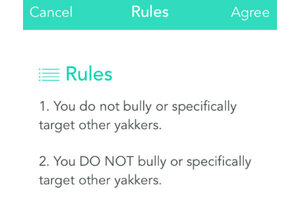Mom vs. Yik Yak: What parents can do to stop bullying via apps
Smartphone and tablet apps meant for messaging friends have become potential platforms for bullies. One Mississippi mom is spreading awareness about the apps that facilitate hate messages. What else can parents do to stay ahead of the technology?

Yik Yak users are asked to agree with terms of use before they post. The first two terms are specifically targeted at curbing bully behavior on the app.
Screenshot from Yik Yak
It should come as no surprise to the parents paying the cellphone bill that teen use of the devices is on the rise. As of two years ago, 37 percent of all teens (ages 12-17) have a smartphone, according to the Pew Research Internet Project, A Nielsen survey in October 2013, showed 70 percent of all teens use smartphones.
But do parents know what apps are on those phones?
Mississippi mom Katrina Johnson is raising awareness in Ocean Springs about the dangers of the app Yik Yak, which serves as a virtual bulletin board, using GPS location to show users messages from those located nearby.
Despite its innocuous purpose, users can post comments anonymously, so in certain cases, the app has morphed into a place where salacious comments, including ones targeting certain children and teens, can be posted without their consent.
"I was in utter shock, absolute utter shock. There was a lot of vulgarity there, explicit things there, specific student names there. They're being degraded," Ms. Johnson told WAFF.com in Huntsville, Ala. "I was in shock initially, then it was panic. It was like these kids that are being made fun of, what are they going through? And we know from the past that other bullying has led to teenage suicide, and that was a huge concern for me," said Johnson.
Some high schools and universities have already recognized the potentially harmful nature of apps like Yik Yak, and have taken steps to curb the use of the app around campus. Recently, Norwich University in Vermont began blocking the app using a geofence (a virtual geographic perimeter), which prevents students from logging onto it on or near their school campus.
The challenges with the app have not gone un-noticed by Yik Yak's creators, who say that they have created their own geofence 1.5 miles around all middle and high schools. But not colleges.
Yik Yak says it's taken steps to set age perimeters on the app, as well as update terms of usage which include explicit language forbidding bullying comments on the app, which users are prompted to review ahead of their first post. Yik Yak also offers a detailed terms of agreement policy which states that users must not "transmit any pornographic, obscene, offensive, threatening, harassing, libelous, hate-oriented, harmful, defamatory, racist, illegal, or otherwise objectionable material or content." The company says it monitors conversations for violations of the policy.
The app is intended for users ages 17 and up, but teenagers are only forbidden from downloading the app if parental controls are activated on their device.
Parents can find tutorials online that help walk through the setup process for parental controls on Apple and Android devices.
In addition to Yik Yak, other apps such as Ask,fm, Snapchat, and Kik also allow bullying opportunities through anonymous posting and the opportunity for other users to vote posts up or down, thus potentially spreading harmful comments.
Beyond monitoring the technology, there are some helpful guides for parents on how to talk to their kids about bullying.
One resource is the book “Words Wound: Delete Cyberbullying and Make Kindness Go Viral” by Justin W. Patchin and Sameer Hinduja, co-directors of the Cyberbullying Research Center. Parents, and others who work with teens, may also find helpful the companion book, “A Leader’s Guide to ‘Words Wound.”
Another excellent tool for monitoring and stopping bullying at school is a web site called Sprigeo, which allows students to report bullying anonymously. According to a recent report by the Kansas City Star, more than 1,000 schools in 27 US states are already using Sprigeo, and it is among multiple services available to help report bullies.
According to the report, in addition to being a resource for teens, it has also proven to be a helpful resource for school officials and teachers to know what’s going on among their students online and behind their backs.
Phones are great for photos, research, and communication. And parents can use a teenager's new phone - or access to new apps - as an opportunity to discuss quality of that communication. After all, online or off, kindness and compassion are

